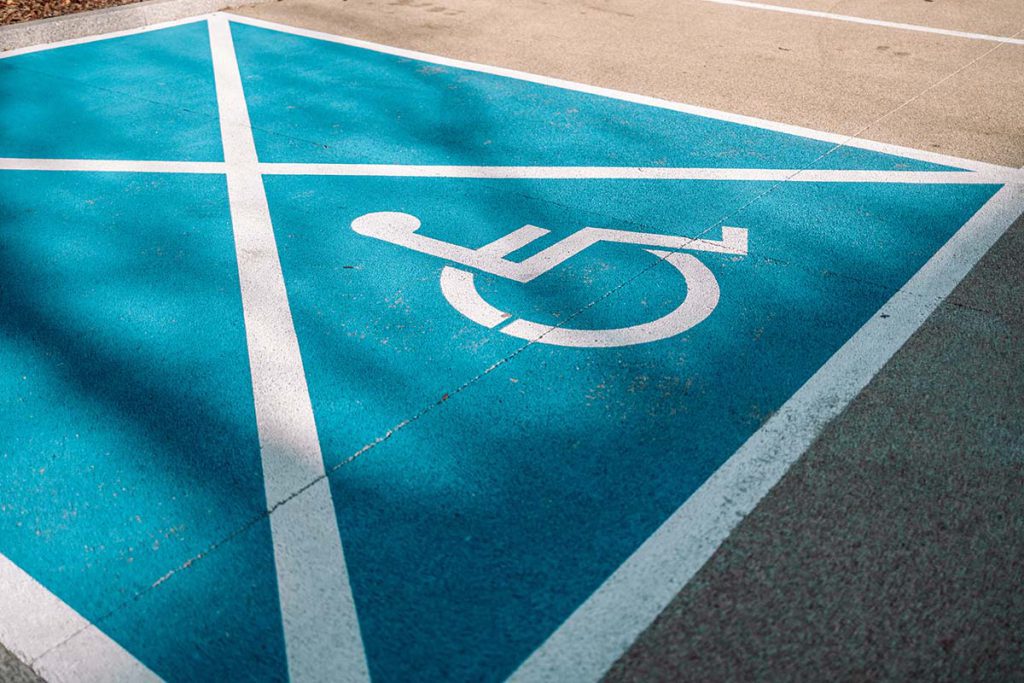Blue Badge Parking Rules: What to Know

When you or someone you care for has a disabled badge for their vehicle, it’s important to understand the blue badge parking rules you have to follow to use it.
Here, we’ll tell you what you need to know about parking with a disabled badge – including the blue badge parking rules for double yellow lines in the UK.
Who issues blue badges in the UK?
Blue badges are issued by local authorities, not a central UK office.
Most of the rules listed below are the same across the UK, but some restrictions (particularly the rules about parking in loading and unloading zones) vary from council to council.
To avoid problems, it’s best to check online or call the office of the local authority where you’ll be parking. That way, you can be sure you’re not breaking any rules. And since misusing a blue badge can lead to a hefty fine, it’s always worth double-checking before you set off on your journey.
Can you park anywhere with a disabled badge?
Put simply, no.
It’s important to remember that blue badges are not designed to give you free parking wherever you want. Instead, they let you park closer to your destination so you can get there more easily if you have limited mobility – even if you have a hidden disability.
Although your blue badge lets you park in several places that drivers without badges can’t, you still have to park in a way that keeps other road users safe.
A blue badge does not let you park:
On or near pedestrian crossings On urban clearways On a road with double white lines in the centreIn a ‘School Keep Clear’ zone In cycle lanes In bus lanes On the pavement In front of a dropped curb In residents’ parking spaces or spaces for designated people (like doctor parking spaces)Or where there are temporary parking restrictions (like cones put out to stop people from stopping during a big event).
What does a blue badge entitle you to?
As long as you park safely, your blue badge makes it easier and cheaper to park in towns and cities across the UK.
Let’s take a look at some of your rights.
Can you park on double yellow lines with a disabled badge in the UK?
Yellow lines painted on the road close to the curb mean there are parking restrictions in that area. They’re there to keep traffic flowing on busy or narrow streets.
Single yellow lines mean no waiting during the times shown on the sign.
Double yellow lines mean no waiting at any time.
Usually, ignoring these restrictions can mean a penalty charge notice for between £50 and £80. But can a blue badge holder park on double yellow lines?
If you have a disabled badge, the rules are slightly different.
You can park on single or double yellow lines if you have a blue badge and it is safe to do so.
In England and Wales, you’ll have to display your badge and the parking clock that came with it. You turn the clock to show the time when you arrived. You can then park for three hours with no return within one hour.
And can you park on a double yellow line with a disabled badge in Scotland? That’s a yes too. What’s more, blue badge parking rules in Scotland don’t include the three-hour restriction, so you won’t need to use a parking clock if you stop on a yellow line.
Free parking for blue badge holders
As well as parking on yellow lines, your blue badge lets you park for free in some places where other motorists have to pay.
In pay and display zones: You can park for free in council pay and display car parks. Instead of displaying your ticket, make sure that your badge is visible through the windscreen.
In some car parks: Places like shopping centres, airports, and hospitals have different rules depending on who runs their car park. You may sometimes be able to park for free if you have a blue badge.
In disabled spaces: Can you park in a disabled bay with a blue badge? Yes! Plus, in many car parks, if you park in a disabled bay without displaying a blue badge, you can be given a penalty charge notice.
In Europe: Many countries in the EU recognise a UK blue badge. This means you can get similar parking privileges if you drive in those countries. You can find the full list of countries with a reciprocal parking scheme here.
Who can use a blue badge to park?
Blue badges are given to individuals or organisations who work with disabled people.
On the front, they have a hologram, a number, the date when they expire, and the name of the council that issued them. On the back, they have your name, badge number and a photo or logo.
The badge clearly states:
‘This badge can only be used by the named badge holder, or by a person who has dropped off or is collecting the badge holder from the place where the vehicle is parked. It is a criminal offence for anyone else to use this badge in any other circumstances.’
This means that blue badges can only be used by a disabled person driving themselves, or by someone who is driving a blue badge holder to their destination or collecting them.
It’s important to understand that there are strict rules about how people use the badge on your behalf.
You can’t lend your blue badge to someone, even if they are running an errand for you. For example, if someone is going to the supermarket for you while you stay at home, they can’t use your blue badge to park in a disabled bay.
You can’t lend your blue badge to someone who is visiting you to let them park closer to your home.
If you have a blue badge but are planning to wait in the car while other people go out, they can’t use your badge to park closer to their destination.
And for organisations, the driver can only use the blue badge to park while they’re taking service users to where they need to be.
How do you display a blue badge when parking?
As well as knowing where you can park with a blue badge and who can use it, it’s important to display the badge properly if you want to avoid a fine.
When you park, you need to put your blue badge photo side down on the dashboard of your vehicle
The most important thing is that the information on the front – the hologram, the number, and the name of the local authority – can be read through the front windscreen. There’s no rule about placing it on the driver’s or the passenger’s side as long as a parking officer can see the number.
It’s really important to make sure that:
You use the original badge. It must be yours, it can’t be a copy, and you can’t change the details on the badge yourself.
The badge is up to date. The front of every badge has a date it was issued and a date when it runs out. They’re usually valid for three years before they have to be renewed, and it’s really important to apply for a new badge before your current badge runs out. It can take between 6 and 12 weeks to process an application, so it’s important to do this in good time. If the badge becomes faded and difficult to read before it’s due to be renewed, you should contact your local authority about getting a replacement.
The information on the badge is valid. You must keep the details on your blue badge up to date, just as you would with your driving licence.
You need the badge. If you no longer need the badge, you have to return it. If you get a new one, if you no longer need it (e.g. because your mobility improves), if you can’t use it (e.g. because you become housebound), or if the blue badge holder dies, you have to send the badge back to the council.
You must also tell your local authority if your badge is lost, even if you don’t want to get a new one.
Blue badge parking rules: penalties for misuse
The fine for misusing a blue badge can be up to £1,000. You might also lose your badge. You must always show the badge to a parking officer if they ask you for it, and they have the power to issue fines and confiscate the badge without involving the police.
You can’t be clamped for parking offences if you have a blue badge, but if your car is obstructing the road, it could still be towed.
Although the list of regulations is quite long, your blue badge should help you to lead a more independent life. Knowing the rules means that the scheme can continue to help people up and down the UK.
Also read:




